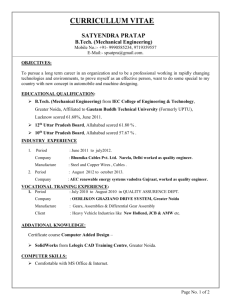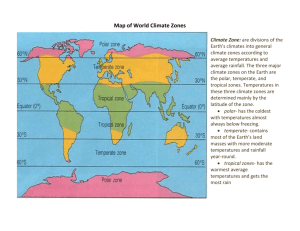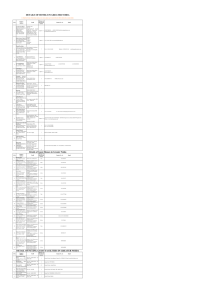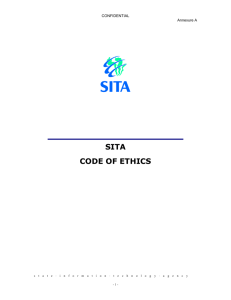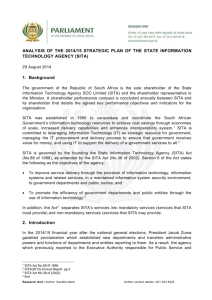Noida Special Economic Zone (India) NSEZ the only Central
advertisement
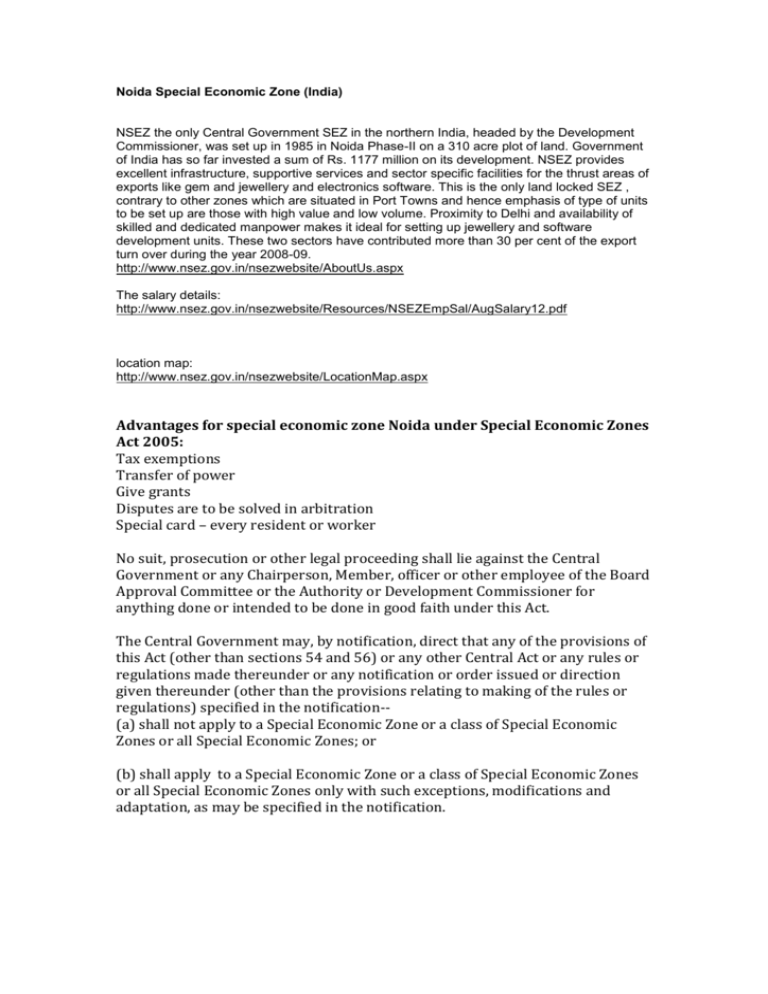
Noida Special Economic Zone (India) NSEZ the only Central Government SEZ in the northern India, headed by the Development Commissioner, was set up in 1985 in Noida Phase-II on a 310 acre plot of land. Government of India has so far invested a sum of Rs. 1177 million on its development. NSEZ provides excellent infrastructure, supportive services and sector specific facilities for the thrust areas of exports like gem and jewellery and electronics software. This is the only land locked SEZ , contrary to other zones which are situated in Port Towns and hence emphasis of type of units to be set up are those with high value and low volume. Proximity to Delhi and availability of skilled and dedicated manpower makes it ideal for setting up jewellery and software development units. These two sectors have contributed more than 30 per cent of the export turn over during the year 2008-09. http://www.nsez.gov.in/nsezwebsite/AboutUs.aspx The salary details: http://www.nsez.gov.in/nsezwebsite/Resources/NSEZEmpSal/AugSalary12.pdf location map: http://www.nsez.gov.in/nsezwebsite/LocationMap.aspx Advantages for special economic zone Noida under Special Economic Zones Act 2005: Tax exemptions Transfer of power Give grants Disputes are to be solved in arbitration Special card – every resident or worker No suit, prosecution or other legal proceeding shall lie against the Central Government or any Chairperson, Member, officer or other employee of the Board Approval Committee or the Authority or Development Commissioner for anything done or intended to be done in good faith under this Act. The Central Government may, by notification, direct that any of the provisions of this Act (other than sections 54 and 56) or any other Central Act or any rules or regulations made thereunder or any notification or order issued or direction given thereunder (other than the provisions relating to making of the rules or regulations) specified in the notification-(a) shall not apply to a Special Economic Zone or a class of Special Economic Zones or all Special Economic Zones; or (b) shall apply to a Special Economic Zone or a class of Special Economic Zones or all Special Economic Zones only with such exceptions, modifications and adaptation, as may be specified in the notification. Sita and her daughters: Women workers at an Indian exportprocessing zone http://www.twnside.org.sg/title/sita-cn.htm In this graphic account of life at an export-processing zone (EPZ) near Delhi, T K Rajalakshmi reveals the terrible price that workers in a developing country pay when it embraces a policy of export-led growth. THE women call it 'the Boundary'. The barbed-wire fence which encloses them for up to 12 hours a day lies hidden behind a facade of manicured lawns and smart-looking buildings of the Noida Export Processing Zone (NEPZ), 24 km from India's capital city. Inside, it is hot, dirty and dangerous. Security is tight - humiliating bodysearches are routine - and trade union activity is forbidden. But for the nearly 4,000 women - many landless, illiterate and unskilled - who work in the zone, the choices are stark: work under these appalling conditions or starve. 'She was six months pregnant. Her baby died in her stomach. It was blue, we learnt later. She was like any other worker who stood for eight or more hours,' an employee who requested anonymity says of a colleague. 'I lied about my marital status at the time of recruitment,' adds another. 'We had to send our three-month-old baby to my parents' home as we cannot afford a private creche.' Established in 1985, NEPZ is one of six such zones in the country. Women make up 40% of its workforce. Like export processing zones (EPZs) across Asia, factories here like to hire women - preferably single - believing them to be more docile and productive than men. Between 1994 and 1996, the number of women workers here tripled while that of men doubled as India pursued an aggressive growth strategy. EPZs have mushroomed around the developing world, vying with one another to offer special incentives to entrepreneurs to set up export-oriented manufacturing units. The assumption is that export-led growth will benefit the economies of developing countries. In Noida, an industrial-cum-residential suburb of New Delhi, such incentives include corporate tax holidays, duty-free imports of capital goods, raw material and components, and exemption from excise duty and other levies on their products. Another government 'gift' grants NEPZ units public-utility status, which mandates that workers cannot take strike action over wages and conditions without a lengthy period of 'conciliation'. Record profits Unsurprisingly, NEPZ has posted record profits - the value of exports increased from Rs720 million (US$16.8 million) in 1990-1991 to Rs6.04 billion (US$141 million) in 1997-1998. But this growth has brought little cheer to the lives of workers, especially women. Wages in the zone are lower than outside and workers have to cope with harsh working and pitiful living conditions - overcrowded slums that lack sanitation, clean water and access to government schools and health services. Maternity benefits are unknown and minimum wages unenforced, particularly in the case of women workers. And employers often avoid making provident fund and gratuity contributions and bonus payments. Dhiraj Singh, a manager at Garmex India, whose export-ready garments are stitched by 600 women and 100 men, is remarkably frank about hiring practices. 'There are so many benefits with women employees,- he says. 'Administratively, it is easy to control women. We do not need to have too much security. We prefer the age group 18 to 30 years, preferably single.' Singh goes on to explain that only married women will ask for maternity leave. Garmex also boasts of a ÔcrecheÕ. In reality it is a storeroom full of cardboard boxes. Savitri (not her real name), a female supervisor in Garmex, confirms the discriminatory practices. Women workers who marry are thrown out, she says. At the time of recruitment, women have to take a compulsory pregnancy test. Those found pregnant are refused work. Overtime is compulsory for most but women are paid lower rates than men. Dismal Women within the Boundary do get pregnant, however, and the health outcomes for them and their infants are often dismal. Miscarriages, premature births and deaths among new-born babies may largely be due to maternal anaemia and poor nutritional status, according to health workers. Dr Pratibha Sharma, who has run a clinic for the last 10 years in a shantytown near NEPZ, says the level of exploitation is 'unimaginable'. She says women workers have frequent abortions - often unsafe - for fear of losing their jobs. Respiratory problems, pelvic inflammatory disease and severe cases of dehydration are common. Anaemia is chronic and severe. Sharma says miscarriages are very common and believes they are due to forced overtime, coupled with women's double burden of having to do housework as well. Quacks proliferate in EPZ slums, providing abortion for a fee. They are sought out by desperate women unwilling to face hostile health workers at government hospitals. 'I see many horror cases,' Sharma says. 'There was a five-month-pregnant woman whose rectum and vagina were perforated due to a faulty abortion.' Daily struggle But horrors lie outside the clinic as well, in the daily lives of women. One such woman is Sita, a Nepalese migrant worker in a surgical gloves factory who heads a household of two daughters ' one of them married with an infant. 'We thought life would be easier for us here but it is a struggle. My daughters have to work as my income alone cannot sustain the family,' she says. Home is a tiny room. And seven families share one toilet. The married daughter sends her child to a creche where she pays Rs500 (US$11.70) every month out of a meagre salary of Rs1,800 (US$42). For Sita and her daughters, the day starts before dawn and ends at midnight. 'All the work that has been left in the morning has to be done in the evening,' she says, adding that her son-in-law 'just sits and orders us around'. Even under these conditions, many women workers are expected to produce sons demanded of them by husbands and parents-in-law. 'The only advantage for these women is that they are staying away from (bullying) in-laws,' notes Dr Sharma. Sita says: I want my daughters to be independent.' (Third World Resurgence No. 107, July 1999) The above article appeared in PANOS Features (1 May 1999). T K Rajalakshmi was awarded the Panos Reproductive Health Media Fellowship in 1998.

